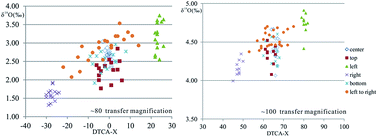Deciphering the physical mechanism of the topography effect for oxygen isotope measurements using a Cameca IMS-1280 SIMS†
Abstract
The surface condition of a sample mount is an important factor influencing the precision of SIMS isotope analysis. The phenomenon that the sample topography affects the analytical precision is called the topography effect. We carried out a systematic experiment of O-isotope analyses using a Cameca IMS-1280 SIMS to quantitatively characterize the topography effect with the aim of better understanding its physical mechanism underlying such an artifact and ultimately improving the analytical precision. Our results indicate that within a mineral grain, the topography effect is obvious in the X-direction (horizontal direction) of the sample stage but insignificant in the Y-direction (vertical direction). In addition, within a single mineral grain, the topography effect creates analytical spots on the left rim (lower X-coordinates) yielding higher measured δ18O values than those on the right rim (higher X-coordinates) in our instrument. The physical reason that the topography effect compromises the analytical reproducibility is attributed to lateral energy dispersion of secondary ions caused by surface topography changing the ion position in the entrance slit plane. By increasing the transfer optics magnification, the topography effect could be significantly reduced. Beam centering parameters could be used to quantitatively assess the topography effect and improve the data quality.

- This article is part of the themed collection: Analytical atomic spectrometry in China

 Please wait while we load your content...
Please wait while we load your content...